
Windows 11 and Windows 10 work on the Steam Deck with official Vale drivers, too. It's not as simple as hitting a download button, though. In this guide, we're going to show you how to install Windows on the Steam Deck, both to the internal solid-state drive (SSD) and from a microSD card.
Windows isn't perfect on the Steam Deck, but installing the OS (or booting from it with a microSD card) can help turn the Steam Deck into a laptop replacement. We're going to show you how to do a full installation to the SSD, as well as how to boot to Windows from a microSD card. The latter will keep the original SteamOS install intact.
Before diving in, keep in mind that Windows 11 isn't technically supported on the Steam Deck. Windows 11 requires TPM, and the Steam Deck doesn't have that enabled. You can still install Windows 11 with the instructions below, but you may not receive Windows updates.
Don't fancy going through all these steps? Why not to try the Asus ROG Ally instead. It has native Windows 11 support, and it's faster, too.
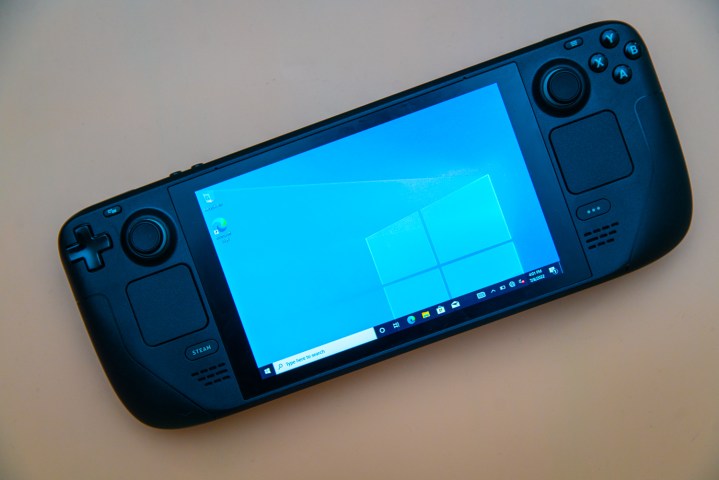
Boot from a microSD card or USB drive
Before actually installing Windows on the Steam Deck, I recommend you boot from a microSD card or USB drive first. This is completely reversible, so you can try out Windows without erasing anything on your Steam Deck. Windows isn't perfect on the Steam Deck, and reinstalling SteamOS is a big task on its own.
I'm using a microSD card, but any UHS-1 microSD card (check the label) or USB 3.0 drive with at least 32GB of storage will work. The Steam Deck supports Windows 10 and Windows 11, and the process is the same regardless of which OS you use. I'm using Windows 10 here.
Step 1: Head to Microsoft's website and download the Windows 10 media creation tool. If you want to use Windows 11, download the Windows 11 creation tool (under Create Windows 11 installation media).
Step 2: Download Rufus, which is what will allow you to create a bootable version of Windows on your microSD card or USB drive.
Step 3: Download the Steam Deck Windows drivers from Valve. (Pay special attention to which version of the Steam Deck you have, as the Steam Deck OLED has different drivers than the LCD version.) Put them all in a folder together on a spare USB drive for access later.
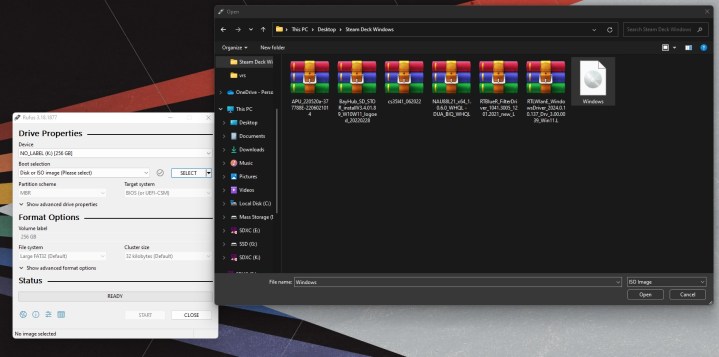
Step 4: Open the Windows Media Creation Tool and select Create installation media. On the next page, choose ISO file, and choose a place to store it on your PC. Wait until the process is done, and make sure to keep a note about where you stored the ISO.
Step 5: Plug in your microSD card or USB drive and open Rufus. Note: Continuing here will erase all data on your microSD card/USB drive. In Rufus, select your microSD card or USB drive under Device. Then, choose Select next to the Boot selection section. Navigate to your Windows ISO that you created earlier.
Under Image option, select Windows To Go. Then, choose MBR under Partition scheme. Rename the drive if you want, and select Ready to start the flashing process.

Step 6: Once it's done, eject the microSD card and insert it in the Steam Deck. Turn off your Steam Deck completely, and then hold down the Volume down button as your power it on. This will enter the boot manager.
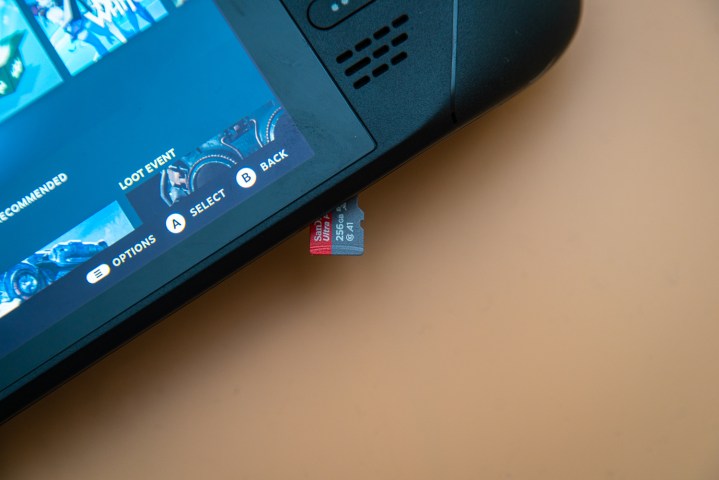
Step 7: Select your SD card to boot into Windows. It will boot in portrait mode on the Steam Deck.
Windows doesn't actually install here, so proceed through the setup process as normal by selecting your language, keyboard layout, etc. A keyboard and mouse help a lot here, but you can get through the setup with just the touchscreen.
Step 8: Once you're in Windows, head to Settings > System > Display and find the Display orientation option. Select Landscape to flip the screen to the proper orientation.
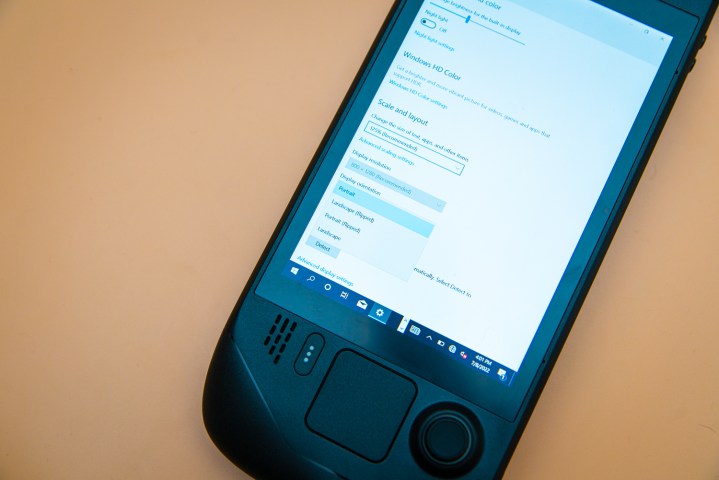
Step 9: Finally, plug in the USB drive that you stored the Windows drivers on. Plug it in using your USB-C hub (not directly into the Steam Deck) and install the drivers.
That's it. When you reboot your Steam Deck, it will go back to SteamOS, but you can always boot into Windows provided you go through the boot manager.
Don't mix up this process with dual booting. The Steam Deck doesn't support dual booting at the moment, so you'll need to choose either Windows or SteamOS if you want a permanent solution.

How to install Windows on the Steam Deck's SSD
If you want Windows only on the Steam Deck, you can install it directly to the SSD. You'll need to erase all of the data on the SSD to do so, though, including your games, settings, and SteamOS itself. Valve has promised a native dual-booting option with a future SteamOS 3 release, but this hasn't arrived yet.
It's possible to restore SteamOS on the Steam Deck, but it's a bit of a hassle. If you just want to experiment with Windows, use the method above. If you're willing to dive into the full experience and don't mind deleting your data, continue on.
Step 1: To start, you need to create a Windows installation drive. We outline how to do that in our guide on how to install Windows 11, but the process is straightforward.
Download the Windows media creation tool and create an installer on your USB drive. You'll need a USB drive with at least 16GB of storage, but the tool will walk you through the steps otherwise.
Step 2: Power down your Steam Deck completely and connect your USB drive with a USB hub. Although you can connect the drive directly, I strongly recommend connecting it with a USB-C hub to avoid any issues. A keyboard and mouse are good for installation, too, and a USB-C hub will allow you to connect those peripherals.
Step 3: Power on the Steam Deck while holding the Volume down button to enter the boot manager. Select your USB drive with the Windows installer to continue.
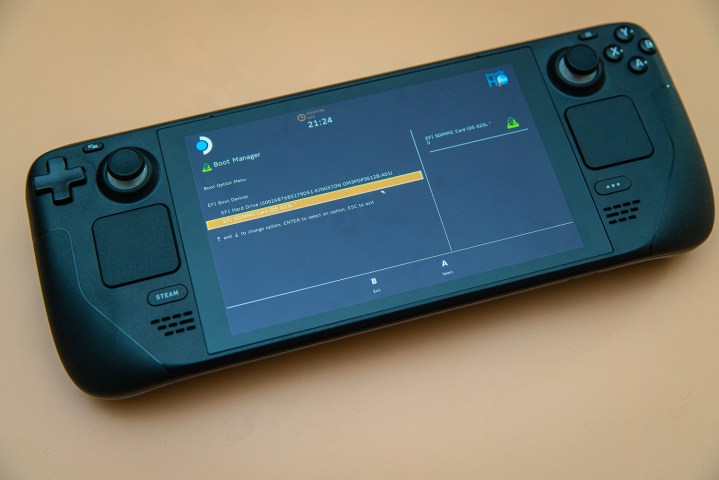
Step 4: Like before, Windows will boot in portrait mode. Select the Windows version you want and then choose Install now. I highly recommend connecting a keyboard and mouse here. You can get through installation with the touchscreen, but the Steam Deck's keyboard and the touchpads won't work.
You'll be asked to activate Windows after. Enter your product key if you have it, or choose I don't have a product key to continue.
Step 5: On the following screen, choose Custom: install Windows only. You'll need to delete partitions on the Steam Deck in order to install Windows.
Important: This will delete all of the data on your Steam Deck, including your games, settings, and any saves/media that haven't been uploaded to Steam Cloud. It's possible to restore SteamOS later, but you'll need to reinstall all of your games and reconfigure your settings.
Step 6: Choose a partition you want to delete and select Delete. I recommend choosing the largest of how ever many partitions you have. The 512GB model, at least, comes with eight partitions.
Step 7: Choose the partition you deleted, which should show up as Unallocated space, and select Next. Windows will begin installing on the drive.
Step 8: After a bit of time and an automatic reboot, you'll load into the normal Windows setup. Proceed as you would above, selecting your keyboard layout, and language, and skipping the Wi-Fi section.
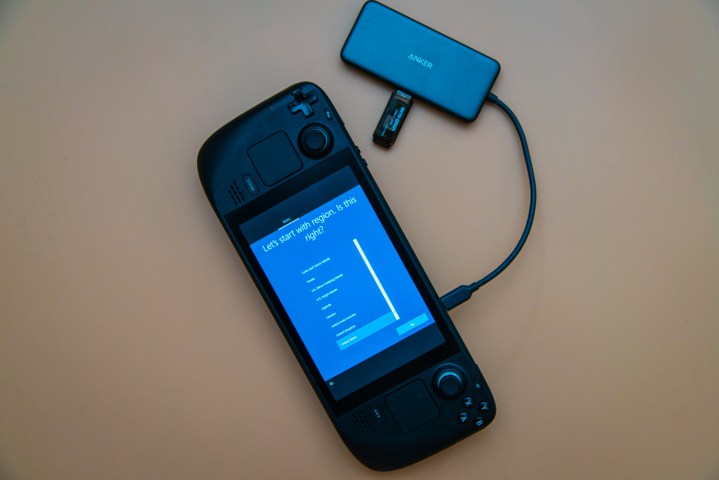
Step 9: Windows is installed at this point, so all you need is a bit of cleanup. Head to Settings > System > Display and switch Display Orientation to Landscape.
Grab another USB drive with the Windows drivers for Steam Deck, and install them as well. SteamOS is gone now, so you'll need to restore it if you want to go back.
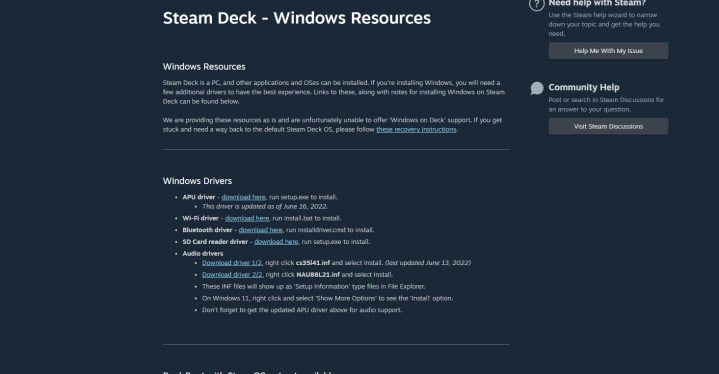
How to recover SteamOS on the Steam Deck
If you installed Windows on the Steam Deck's SSD and you want to go back, you can. Valve offers a Steam Deck recovery image that will get SteamOS back in working order — provided you're OK with factory resetting your Steam Deck once again.
Step 1: To start, download the SteamOS recovery image from Valve.
Step 2: Download Rufus on a separate Windows PC and insert a USB drive. Write the SteamOS recovery image to the USB drive and eject it from your PC.
Step 3: Power down the Steam Deck completely and connect the USB drive using a USB-C hub. Hold the Volume down button while powering on the Steam Deck to enter the boot manager. Select your USB drive from there (it should be "EFI USB Device").
Step 4: After some time, you will boot into the recovery environment. There are a few options here that will attempt to preserve your data, but I recommend using the Re-image Steam Deck option.
If you're coming from Windows, you'll need to factory reset the Steam Deck to get it working. Attempting the other options won't keep your games if you've already installed Windows, and they could lead to some nasty file system conflicts.
Troubleshooting Windows on Steam Deck
If you are installing internally, make sure that the partition you choose is formatted as NTFS. Otherwise, it may not be compatible with Windows.
Some games will just run better in Steam OS than they will in Windows, especially with workaround methods. If you are running into performance issues with your game, it could be Windows: You may want to use our steps to revert to SteamOS.
Your games may need to be booted through Steam on Windows to use the Steam Deck control pad. There is also the SWICD workaround for games that aren't on Steam, but that's an extra step and customization process you'll have to make time for.
Compatibility with audio drivers may be limited. Using Windows 11 and its latest updates is the best way to ensure you don't run into audio issues.
For frequent Windows use on the Steam Deck, we highly recommend switching to a portable SSD instead of a microSD card
Frequently asked questions
Can Steam Decks run .exe files?
Yes, if you have Windows installed on a Steam Deck, you should be able to run .exe files on it.
Can Steam Decks run all Windows games?
Steam Decks can run Windows games but not necessarily all Windows games. Just as not all Windows computers can run Windows, your Steam deck may not be powerful enough for each Windows game that comes out. Be sure to check system requirements and any other compatibility issues. When in doubt, ask the game's community members if they have had any luck running the game on a Steam Deck.
What OS does the Steam Deck use?
The Steam Deck uses SteamOS. If you don't like SteamOS, you can install Windows on your Steam Deck instead, via the directions detailed above.
The Asus ROG Ally is a viable contender to the Steam Deck's portable PC throne. Not convinced? Check out our head to head of these two system to see how the ROG Ally versus Steam Deck goes down.




